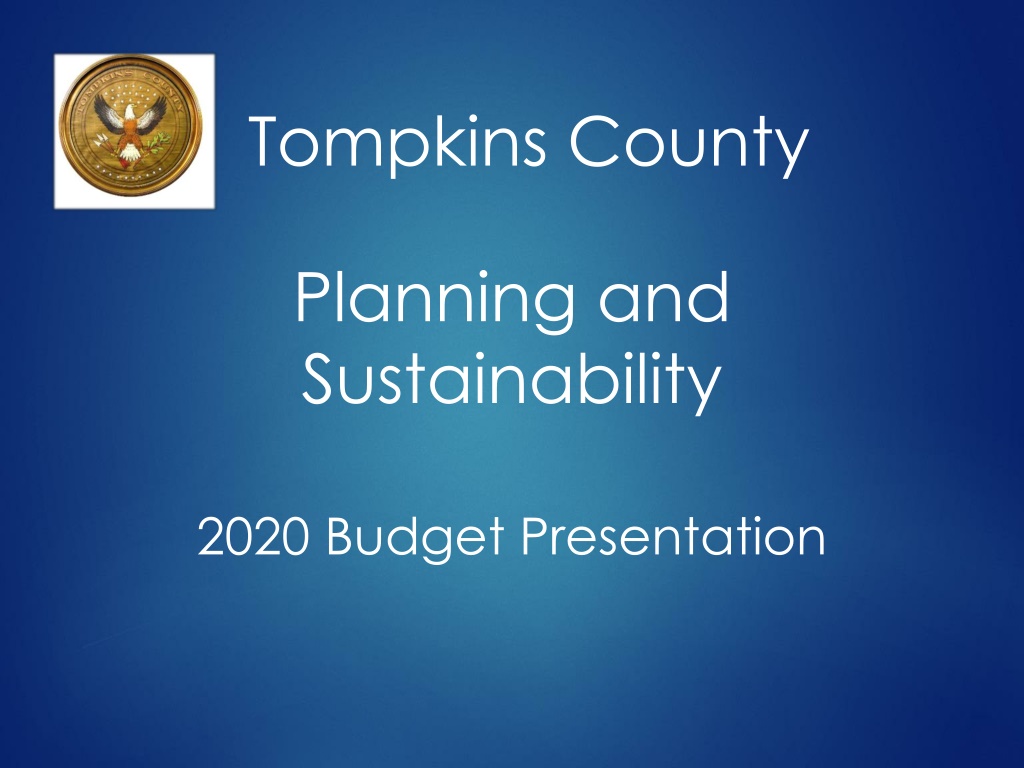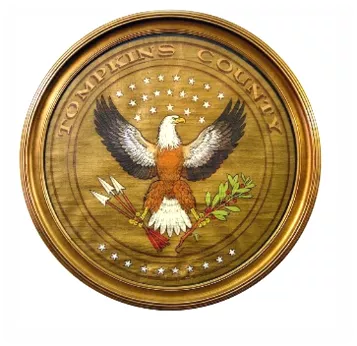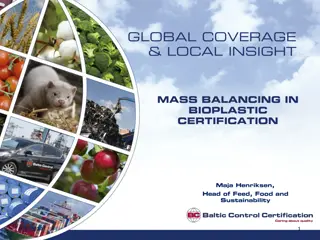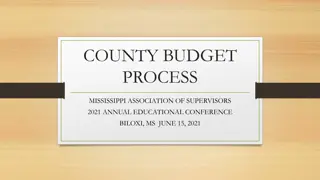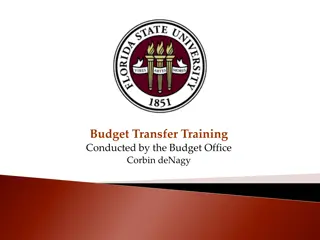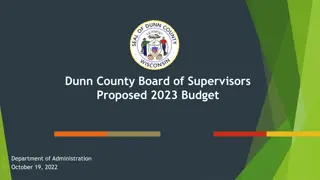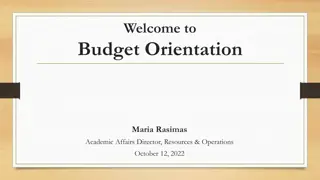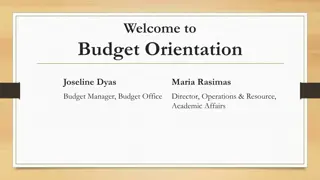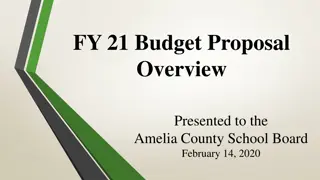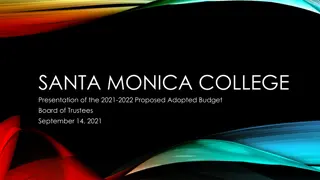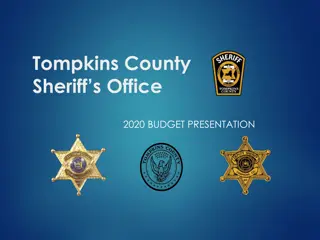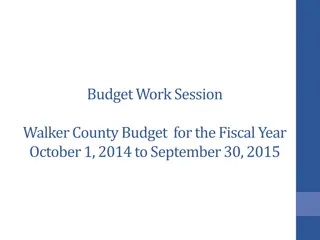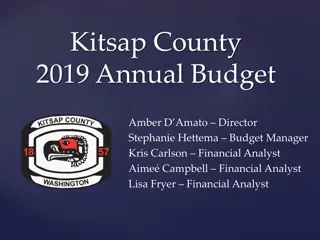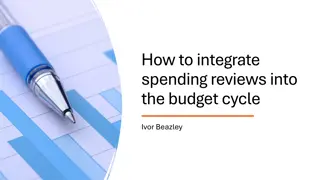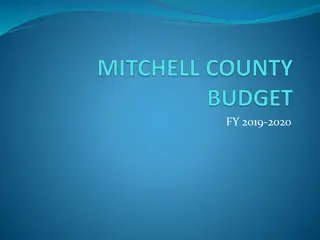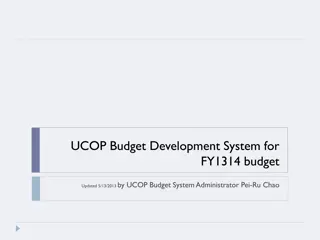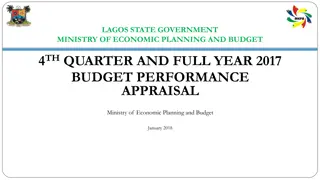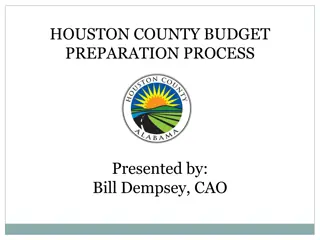Tompkins County Planning and Sustainability 2020 Budget Overview
The budget presentation for Tompkins County Planning and Sustainability in 2020 outlines a recommended budget with significant changes in expenditures and revenues. The document highlights major influences such as energy, climate change, affordable housing, water quality, and tourism. It also includes details on full-time equivalents, over-target budget requests, and specific programs like the Business Energy Advisors Program. The presentation focuses on key areas of investment and strategic planning for the county's sustainable development and resilience in the face of environmental challenges.
Download Presentation

Please find below an Image/Link to download the presentation.
The content on the website is provided AS IS for your information and personal use only. It may not be sold, licensed, or shared on other websites without obtaining consent from the author. Download presentation by click this link. If you encounter any issues during the download, it is possible that the publisher has removed the file from their server.
E N D
Presentation Transcript
Tompkins County Planning and Sustainability 2020 Budget Presentation
Recommended Budget 1 2019 Modified 2020 Recommended $ Change % Change Expenditures $1,900,040 $1,394,360 -$505,680 -26.61% Revenues -$796,950 -$362,861 $434,089 -54.47% Net Local $1,103,090 $1,031,499 -$71,591 -6.49% Grants that show up in 2019 budget, but not in 2020 = $372,350 Resiliency and Recovery Plan, Cayuga Lake Blueway Trail improvements, Electric Vehicle purchase support Department electric vehicle purchase in 2019: $35,800 Municipal Parks and Recreation Grant Funds: $50,000
Major Influences 2 Energy, Climate Change, Adaptation Net-zero emissions - electrification of heating, cooling, transportation Natural disasters - especially for flooding, drought Affordable Housing and Focused Development Housing for homeless to moderate income near jobs/services Ability for businesses to recruit and retain workforce Water Quality: Harmful Algal Blooms and Cayuga Lake TMDL Protect recreational amenities and public water systems Tourism Increasing visitor-nights in off-season and supporting attractions
Full-Time Equivalents 3 2020 Target 2020 Rec. # % 2017 2018 2019 Change Change 8.82 10.70 10.70 9.70 10.70 0 0 Requesting target funding for Senior Planner Energy Specialist
Over-Target Requests Supported by the Recommended Budget 4 Page # OTR # Req. OTR Req. Source Rec. OTR Rec. Source Priority Purpose $101,310 Target $101,310 Target Business Energy Advisors Program 4-151 24 1 -$55,000 One-Time -$55,000 One-Time Municipal Housing Affordability Infrastructure Grant 4-152 25 2 $30,000 One-Time $30,000 One-Time Southern Tier 8 Membership Dues 4-152 26 3 $10,000 One-Time $10,000 One-Time
OTR 24: Business Energy Advisors Program (Budget Book p. 151) 5 Request Not requesting year 3 of the 3-year OTR ($50,000) Requesting $46,310 in target as step 1 of a 2-step process for full target funding in 2021 $101,310 -$55,000 $46,310 Account Amount Type 42070 CONTRIB FR PRIV AGENCIES TCAD for Consultants $ -35,000 One Time 43959 STATE AID PLANNING NYSERDA Grant to Offset 2020 Target Cost $ -55,000 One Time 51000679 SR PLANNER-ENERGY SPEC $ 62,962 Target 58800 FRINGES $ 30,133 Target 54400 PROGRAM EXPENSE $ 1,815 Target 54442 PROFESSIONAL SERVICES TCAD to Consultants $ 35,000 One Time 54442 PROFESSIONAL SERVICES $ 6,400 Target
OTR 24: Business Energy Advisors Program 6 Goal Decrease GHG emissions from businesses and County government Predictability for businesses and staff In addition to BEA: Assist with County projects (e.g., airport geothermal RFI) Assist the County in achieving its vision for net-zero emissions
OTR 24: Business Energy Advisors Program Progress Report 7 NYSERDA grant goal was to conduct energy charrettes for 30 businesses by end of 2020 63% of goal achieved by end of first full year (Aug 2019) Positive reviews from participating businesses Our participation in the BEA program was transformational for our project it enhanced both the energy and financial performance of the building. With the help of [the BEA team], we took another look at our design, budget and associated grants. We believe our current design is friendlier to our environment based on the changes we have made.
OTR 25: Municipal Housing Affordability Infrastructure Grant (Budget Book p. 152) 8 Request Last year 1-year OTR using $45,000 of rollover Continue as year 1 of a 3-year program through 2022 Includes $20,000 of rollover funds for 2020 Predictability for municipalities that funding will be available After 2022, assess the program to determine impact on affordable housing
OTR 25: Municipal Housing Affordability Infrastructure Grant 9 Goal Assist municipalities pursuing efforts to support housing affordable to County residents Encourage collaboration and partnership between the County and municipal governments Increase the amount of affordable housing Improve and maintain existing housing Assist infrastructure needs in nodes
OTR 25: Municipal Housing Affordability Infrastructure Grant 10 Progress Report Since March 2019, two projects have been funded: Town of Lansing nearly contracted with a consultant Town Center Traffic Study a multimodal transportation impact assessment for a full buildout of the Town owned land that will be incorporated into a GEIS for the whole area to streamline approval for all future projects ($10,000) Village of Dryden hired a consultant Surveying housing conditions in preparation for submitting a CDBG Rehab application when they are announced this fall ($5,000)
OTR 26: Southern Tier 8 Membership Dues (Budget Book p. 152) 11 Request Year 3 of 3-Year OTR: In 2018 County re-joined the Southern Tier 8 Regional Board (ST8) with understanding that it was for a 3-year period with evaluation in year 3 Annual dues are $10,000 Monthly meetings with other planning directors If funded, next year will do an assessment to determine the impact of membership
OTR 26: Southern Tier 8 Membership Dues Goal 12 Increase collaboration with regional partners in support of Comprehensive Plan s overarching principle ST8 operates under joint resolution of legislative bodies of member counties: Broome, Chenango, Cortland, Delaware, Otsego, Schoharie, Tioga and Tompkins ST8 s 5-Year Plan Goals Develop Regional and Local Economic Development Strategies Create a region where individuals have the opportunity to improve their employment status Address Infrastructure Deficiencies Adopt Regional Marketing Strategies Create Innovative Approaches to Community Well-Being Issues Develop Strategies to Focus on Our Small, Rural Communities
OTR 26: Southern Tier 8 Membership Dues 13 Progress Report Participating on steering committee for Energy Infrastructure Assessment and Strategy for all eight Counties Informative workshops (Southern Tier Industry Summit; Agriculture and Food Industry Summit) Town of Newfield, Groundswell Center for Local Food and Farming, and Cornell Cooperative Extension of Tompkins County were all approved for Appalachian Regional Commission (ARC) Area-wide Grants funding from 2018 applications (total $234,481) In 2019 helped 3 TC applicants compete for funding for ARC grants
Over-Target Requests NOT Supported by the Recommended Budget 14 Page # OTR # Req. OTR Req. Source Rec. OTR Rec. Source Priority Purpose 4-153 27 4 $10,000 One-Time $0 One-Time Advisory Board Priorities
OTR 27: Advisory Board Priorities (Budget Book p. 153) 15 Goal Support activities of advisory boards appointed by the Legislature Request: New 1-year OTR - There are two parts to this OTR: 1. EMC Climate Action Committee ($2,000) to conduct public education on environmental matters Print brochures to promote steps that can be taken by residents, farms, and small businesses to ameliorate and control flooding and to adopt carbon-sequestration practices 2. WRC Clean Boating Map ($8,000) to design and print 2,000 copies of a map of Cayuga Lake showing boating services and information on clean boating techniques to reduce contamination and spread of invasive species Legislature funded as OTR in 2019. In case they cannot complete this work in 2019, they have requested these funds be available to them in 2020
Tourism Program Budget 16 Local Law No. 4-1989 Authorizes the County to collect Hotel Room Occupancy Tax 100% of program revenue comes from that tax All grant awards require legislative approval Proposed budget approved by Strategic Tourism Planning Board each July No Over Target Requests
Tourism Program Budget 17 2019 Modified 2020 STPB Recommended $ Change % Change Expenditures $3,081,649 $3,033,153 -$48,496 -1.57% Revenues -$2,935,000 -$3,050,760 -$115,760 3.94% Use of/Addition to Reserves -$146,649 $17,607 $164,256 112% Net Local $0 $0 $0 0% Expenditures include: $544,069 Other allocations (Budget Book p. 34) Administering the room tax County allocated10% TCAD - general operating support Planning and Sustainability staff support $544,069 +$2,489,084 $3,033,153 $2,489,084 Tourism Promotion (Budget Book p. 194) 2018 STPB set a policy to maintain a 5% reserve balance
Revenue Room Tax 18 2020 Forecast of $3,050,760 Room Tax revenue 2020 Room Tax Forecast by Quarter 4% increase compared to 2019 Forecast $1,200,000 $1,000,000 $800,000 $600,000 $400,000 $200,000 $- Q1 (Dec - Feb) Q2 (Mar - May) Q3 (Jun - Aug) Q4 (Sep - Nov)
Expenditures Room Tax 19 2020 Room Tax Allocation STPB uses 60/40 policy: $306,430 Marketing 60% $305,076 Product Development 40% Forecast $183,000 contribution to general fund $1,463,650 $975,604 Marketing Product Development 10% Tax Administration Other
20 Thank you for your support!
